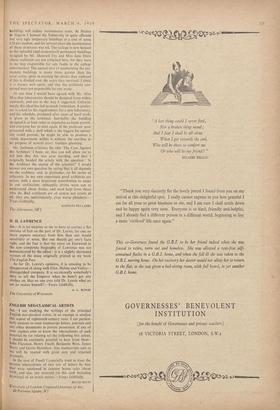THE CASE AGAINST THE ARCHITECT
SIR,—Your correspondents, Mr. James K. Scott and Mr. F. L. Jackman, seem to be so angry because haVe dared to criticise part of the work of some architects that they have not even mad my article! I certainly do not wish to 'prejudice the livelihood of another profession.' My main theme was that I dis- agreed with the many scientists who have no usb for architects..) want architects to build more and better buildings, including laboratories, and to build them more cheaply. 1 think that this can be achieved if architects will keep their hands off those parts of the work they seem least good at. Mr. Jackman sayS that my statements on taps and drains are 'blatantly silly.' If he could only eavesdrop when a group of young scientists from different institutions which have recently been rehoused get together! He would hear one man after another cap the previous story of some 'blatantly silly' mistake of the architects in relation to laboratory fittings, and would realise that my examples are almost sensible in comparison. He also accuses me of dragging up 'the old canard about architects making buildings more expen- sive to increase their fees'; this belief is widely held, but I said that I personally did not hold it.
I believe good buildings are supremely important, and that only architects can design them, Such build- ing must, however, justify themselves as buildings and not on the score that they save money. They must, hoyvever, be erected without unnecessary expense, and I believe that, whatever architects may say, they often cause such expense. My confidence in Mr. Jackman is not further increased when I find him repeating the statements so often made by architects that good
buildings will reduce maintenance costs. At lbadan in Nigeria I housed the University in quite efficient but very ugly temporary buildings at a cost of some £50 per student, and for several years the maintenance of these structures was nil. The•college is now housed in the splendid (and economical) permanent buildings designed by Mr. Maxwell Fry and Miss Jane Drew (these architects are not criticised here, for they were in no way responsible for any faults in the college laboratories). The annual cost of maintaining the per- manent buildings is many times greater than the total outlay spent in erecting the shacks they replaced if this is divided over the years they survived. I think it is money well spent, and that the architects con- cerned were not responsible for any waste.
At one time I would have agreed with Mr. Alan May that laboratories should be designed from within outwards, and not in the way I suggested. Unfortu- nately this ideal has led to much frustration. A profes- sor is asked for his requirements for a new laboratory, and his schedule, produced after years of hard work, is given to the architect. Inevitably the building designed is at least twice as expensive as funds permit, and everyone has to start again. If the professor were presented with a shell which is the biggest his univer- sity could provide, he might be able to produce a viable department within it without the sacrifice to no purpose of several years' fruitless planning.
Mr. Jackman criticises the title 'The Case Against the Architect.' I hope, sir, that you will allow me to tell him that this was your wording, and that I originally headed the article with the question : 'Is the Architect the enemy of the scientist?' I would answer my own question by saying that it all depends on the architect, and, in particular, on his terms of reference. In my own experience good architects are artists, with a most important contribution to make to our civilisation; unhappily artists seem not to understand about drains, and need help from those who do. Bad architects are of course not artists at all; they are, unfortunately, even worse plumbers.— Yours faithfully, ' KENNETH MELLANEW



































 Previous page
Previous page